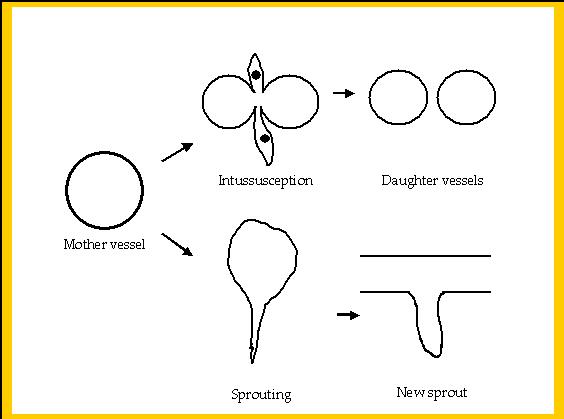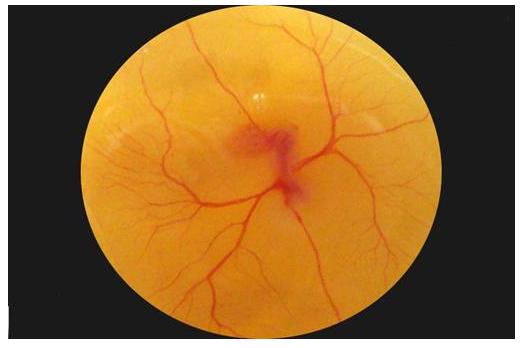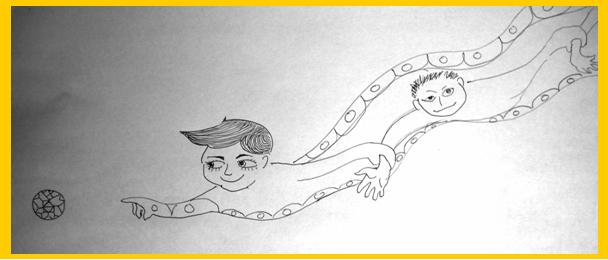Vascular Biology Lab - Angiogenesis
Angiogenesis, is the term used to describe the growth of new capillary blood vessels in the body. It is an important natural process, used for healing and reproduction. The body controls angiogenesis by producing a precise balance of growth and inhibitory factors in healthy tissues. The fundamental structure of blood vessels is a thin inner layer of endothelial cells. Therefore, the building block of angiogenesis is endothelial tubes. We investigate the behaviour of endothelial cells upon treatment with angiogenesis active pharmacological compounds and proteins. We study both pro-angiogenic and anti-angiogenic events to understand the underlying signaling mechanism of the actives.
Angio means, “ of blood or lymph vessel”
and genesis means, “beginning an origin”
Briefly, it’s a physiological
process involving the growth of new blood vessels from pre-existing
vessels. It is a normal process in growth and development, as well
as in wound healing. However, this is also a fundamental step in
the transition of tumors from a dormant state to a malignant state
Though there has been some debate
over the terminology of Angiogenesis, broadly we have 2 different
process of blood vessel formation:
Vasculogenesis,
a term used for spontaneous blood-vessel formation.
Intussusception,
a term for new blood vessel formation by splitting off existing
ones.
Types of angiogenesis
Sprouting
angiogenesis
Angiogenic factors activate receptors
on endothelial cells of the existing blood vessels. In response
to which proteases are secreted that degrade basement membrane and
the endothelial cells are set free to proliferate in the surrounding
matrix forming solid sprouts attaching neighboring blood vessels.
These sprouts extend towards the angiogenic stimulus, in the process
they are transformed into full- fledged vessels as pericytes and
other cells migrate to the site

Intussusceptive
angiogenesis
It is also known as splitting angiogenesis,
because during this the vessel wall extends into the lumen to split
a single vessel into two. First, the two opposing capillary walls
establish a zone of contact. Second, the endothelial cell junctions
are reorganized and the vessel bilayer is perforated to allow growth
factors and cells to penetrate into the lumen. Third, a core is
formed between the two new vessels at the zone of contact that is
filled with pericytes and myofibroblasts. These cells begin laying
collagen fibers into the core to provide an extra cellular matrix
for growth of the vessel lumen. Finally, the core is fleshed out
with no alterations to the basic structure. Intussusception is important
because it is a reorganization of existing cells. It allows a vast
increase in the number of capillaries without a corresponding increase
in the number of endothelial cells. This is especially important
in embryonic development, as there are not enough resources to create
a rich microvasculature with new cells every time a new vessel develops.
Therapeutic
angiogenesis
.JPG)
.JPG)
Micro CT scans of cirrhotic mouse
liver
Reconstruction
Voxel: 20 m m; Display Voxel: 40 m m
Therapeutic angiogenesis is the
application of specific compounds, which may inhibit or induce the
creation of new blood vessels in the body in order to combat disease.
The presence of blood vessels where there should be none may affect
the mechanical properties of a tissue, increasing the likelihood
of failure. The absence of blood vessels in a repairing or otherwise
metabolically active tissue may retard repair or some other function.
Several diseases (eg. ischemic chronic wounds) are the result of
failure or insufficient blood vessel formation and may be treated
by a local expansion of blood vessels, thus bringing new nutrients
to the site, facilitating repair. Other diseases, such as age-related
macular degeneration, may be created by a local expansion of blood
vessels, interfering with normal physiological processes.
Factors that stimulate
Angiogenesis
Mechanical stimulation
Mechanical stimulation of angiogenesis
is not well characterized. There is a significant amount of controversy
with regard to shear stress acting on capillaries to cause angiogenesis,
although current knowledge suggests that increased muscle contractions
may increase angiogenesis. This may be due to an increase in the
production of nitric oxide during exercise.
Chemical
stimulation
Various different chemical stimulants have been
identified, characterized and worked upon that stimulate the process
of angiogenesis and vasculogenesis. Few of the chemical stimulants
comprise; VEGF, MMP, FGF, DII4.
VEGF or Vascular endothelial growth
factor, as the name suggests mostly works on the endothelial cells
and promotes blood vessel formation by catering to both vasculogenesis
and angiogenesis.
MMP or Matrix metalloproteinase
are secreted in response to different pro-angiogenic signals. They
help in the degradation of extra cellular matrix and there by facilitate
the migration of endothelial cells and pericytes, an important step
in initiation of angiogenesis.
FGF or Fibroblast growth factors
are heparin-binding proteins. They stimulate the growth and proliferation
of endothelial cells. They also aid in the physical arrangement
of endothelial cells in tube structures.
PDGF or Platelet derived growth
factors are growth factor proteins derived from platelets and aid
in the growth and proliferation of endothelial cells.
Recently some new pro-angiogenic
factors have been identified like DII4, which stimulates angiogenesis
in ways similar to VEGF.
Vasculogenesis

The Debate
over Angiogenesis and Vasculogenesis
For long there has been debate
over the terminology to be used for the process of blood vessel
formation. Different schools of thoughts classify the process differently
and depending on the source of blood vessel formation the process
has been categorized in Vasculogenesis and Angiogenesis.
Vasculogenesis
is the process of blood vessel formation occurring by a de novo
production of endothelial cells. Though it is similar to angiogenesis,
the two are different in one aspect:
The term angiogenesis
denotes the formation of new blood vessels from pre-existing ones,
while vasculogenesis is the term used for the formation
of new blood vessels when there are no pre-existing ones.
Interestingly, if a monolayer of
endothelial cells begins sprouting to form capillaries, Angiogenesisis
occurring.
While, Vasculogenesis,
in contrast is the term, when endothelial precursor cells migrate
and differentiate in response to local cues (such as growth factors
and extra cellular matrix) to form new blood vessels.
First, believed to occur only during
embryologic development, but recently, however, it was realized
that vasculogenesis can also occur in the adult organism. Circulating
endothelial precursor cells (derivatives of stem cells) have been
identified and reportedly able to contribute, albeit to varying
degrees, to neovascularization, such as during tumor growth, or
to the revascularization process following trauma, e.g. after cardiac
ischemia.
Angiogenesis-current
developments
Tip cells
; the directional behavior of vessel growth during sprouting angiogenesis.

In sprouting angiogenesis,
specialized endothelial tip cells lead the outgrowth of blood vessel
sprouts towards gradients of vascular endothelial growth factor
(VEGF). These cells are different from endothelial cells at the
base in respect to their response to VEGF. The tip cells respond
to VEGF-A only by guided migration; the proliferative response to
VEGF-A occurs in the sprout stalks. These two cellular responses
are both mediated by agonistic activity of VEGF-A on VEGF receptor
2. Whereas tip cell migration depends on a gradient of VEGF-A, proliferation
is regulated by its concentration. Thus, vessel patterning during
retinal angiogenesis depends on the balance between two different
qualities of the extra cellular VEGF-A distribution, which regulate
distinct cellular responses in defined populations of endothelial
cells. VEGF-A is also essential for the induction of endothelial
tip cells, but it is not known how single tip cells are selected
to lead each vessel sprout, and how tip-cell numbers are determined.
There have been reports of delta-like 4 (Dll4)–Notch1 signalling
regulates the formation of appropriate numbers of tip cells to control
vessel sprouting and branching in the mouse retina.

Prima-facie objective of our lab
is to study the physiology of Angiogenesis. We are looking at the
basic science of Angiogenesis for a better understanding of the
subject and also at the same time trying to apply our understanding
in application to present new avenues and inventions. Keeping our
main focus on Angiogenesis we are trying to explore all the possible
avenues of the subject. Our research can be divided into:
Basic
Science and Applicative Research
We are constantly striving to find
the basics of Angiogenesis and the factors affecting it. Presently
we are working on the effect of Cadmium toxicity and its effect
on Angiogenesis. Another interesting area that promises immense
potential is, Shear stress and its effect on Angiogenesis. The subject,
even though interesting has not been explored much, is gaining attention
lately. We are working in the area as our approach to enlighten
the area of Basic Angiogenesis.
“Inventions are incomplete
without application.” Driven by the core thought we always
strive to find applications to our present knowledge. We are trying
to apply our knowledge of Angiogenesis to regulate the growth of
blood vessels, which can be applied in treatment of various anomalies
involving blood vessels including Cancer. We are working to find
new therapeutic agents for controlling Angiogenesis. We have been
working a potential anti-angiogenic protein Ang-001 that promises
to be of great potential in combating malignancy and tumors.
Another major applicative area we
are working on is the growth of blood vessels in-vitro. We are working
on the prospects of Micro-gravity and its effects on Angiogenesis.
Many reports have shown that tissue growth is enhanced under zero
gravity and micro gravity conditions. We are trying to understand
the effect of micro-gravity environment on Angiogenesis and the
applications of the field.

 


Prominent angiogenesis
labs and foundations worldwide
Angiogenesis foundation
http://www.angio.org/index.html
American
Heart Association
http://www.americanheart.org/presenter.jhtml?identifier=1200000
Angiogenesis Laboratory
Maastricht, Netherlands.
http://www.fdg.unimaas.nl/angiogenesislab/
National Cancer Institute
http://www.cancer.gov/cancertopics/understandingcancer/angiogenesis
Mukhopadhyay Lab (Tumor
Angiogenesis and Vascular Biology)
http://mayoresearch.mayo.edu/mayo/research/dev_lab/
Angiogenesis Research Centre,
Dartmouth
http://www.dartmouth.edu/~angio/about.html
Judah Folkman’s Lab
http://www.childrenshospital.org/cfapps/research/data_admin/Site336/mainpageS336P0.html
Prof. Judah Folkman, MD
http://www.childrenshospital.org/cfapps/research/data_admin/Site105/mainpageS105P0.html
List Of People Working In
Tumor Invasion And Angiogenesis
http://tango01.cit.nih.gov/sig/members.taf?_function=list&SIGID_uid1=109&_UserReference=3DCD3A75BF278EFA46123D97
Avastin (webpage of the
first anti-angiogenic drug)
http://www.avastin.com/avastin/index.jsp?hl=en&q=avastin&btnG=Search&meta=
http://en.wikipedia.org/wiki/Angiogenesis
Journals devoted to angiogenesis
and related fields
Angiogenesis
Endothelium
Circulation
research
Circulation
BLOOD
Webpage design

Ajit Muley
|

